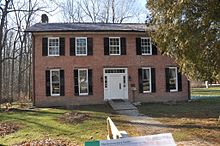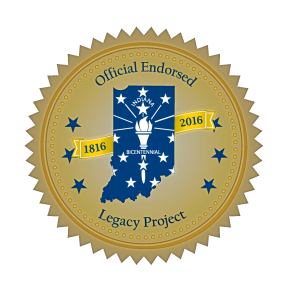IF THE RIVER COULD TALK
MOUNDS PARK: A SPOT OF BEAUTY
Enjoyed for Thousands of Years
An artesian well was a popular place for visitors to Mounds Amusement Park to get a drink of water. The park closed in 1928, ending a 30-year run.
The Bronnenberg House(right) has been restored and now is a popular and interesting part of the Mounds Park experience.

Known as the Mound-Builders, it's theorized they were descendants of a people who once lived in Mexico and Central America, primarily because the earth works here are similar in design and arrangement to those found in those regions. Over time they immigrated to North America's Gulf Coast and eventually up the rivers to the Ohio Valley.
Archeologists have identified two distinct groups of ancient people from different time who built the mounds. The first group is classified as the Adena culture, and the second as the Hopewell culture. If the river could talk, it would tell of the Adena were here from roughly 1,000 to 200 B.C. and the Hopewell from 200 B.C. to 500 A.D.
Something or someone caused them to depart this area. One theory is they were forced out by others hostile to their existence here. And, faced with that danger, they returned to the central Americas. The mounds were left virtually undisturbed for the next 13 centuries.
If the river could talk, it would tell of a family called Bronnenberg that arrived at the mounds site in the 1820s. Frederick Bronnenberg Jr. built a two-story brick house within sight of the Great Mound in 1840. For the next 57 years, Frederick and his descendants kept watch over the mounds, occasionally chasing away an unwelcome visitor who sought to tread upon the delicate earthworks. However, in 1897, a big change was about to take place at the ancient ceremonial site.
Amusement Park
A new kind of visitor, one seeking amusement, began to arrive in patrons to the new Mounds Amusement Park. If the river could talk, it would reveal that thousands of people it witnessed enjoying the park during its 31 years of existence. From high upon a 75-foot river bluff, one could hear the joyful sounds of a miniature train's passengers, as they circled the Great Mound and, in later years, wound its way through the park.
Those sounds were often mixed with the shrill sounds of screaming adults and children as they experienced the thrill of riding the park's roller coaster known as Leap The Dips; especially when the wooden coaster's cars would "fly" around the sharp curve that hugged the river bluff, providing the rider with the notion that this trip to the brink of that high precipice would certainly be their last!
A very popular attraction provided yet another sound that resounded over the river below. Known as the Pavilion, it was a two-story wooden structure where food and drinks were served on the first floor. However, what was well remembered by park goers was how music wafted out through the open windows from the second-story dance floor, reaching across the park grounds and down to the river.
While the river could only hear the sounds coming from above, it was witness to the pleasure experienced by those who ventured to the river to partake of a canoe ride. While waiting their turn, thirsty patrons could drink to their satisfaction from the water provided by an artesian well located nearby. Regardless of rainfall amounts, a pleasurable canoe excursion was assured throughout the summer season by a man-made stone dam constructed near the point where a trail brought visitors down to the river from the amusement area above.
From the dock, patrons were free to explore the river however they wished. The only rule was they could not go beyond the park's boundary, which in the case of the river was identified as the Pest House bridge crossing at East Tenth Street. That freedom to explore did not include the occasional tip-over providing the unsuspecting canoeist with an unwelcome dip in the river. Flat bottom boats were eventually added to circumvent this problem.
If the river could talk, it would tell of hearing native Americans, specifically Delaware, refer to it by two names. One was Wapahani and the other Wapeksippu. Both translated in the Delaware Indian language to "at a place where there is much white earth."
The Mounds Amusement Park closed at the end of the 1928 season. Speculators looked with an envious eye upon the area with a view to develop the area. Fortunately, the Madison County Historical Society stepped in and raised money to purchase the former park and deed it over to the county, which in turn gave it to the State of Indiana with the provision it be made into a state park.
On October 7, 1930, Mounds State Park became a part of Indiana's state park system.
If the river could talk, it would reveal to all the countless number of people who, over the centuries, have discovered the unique and beautiful area that is know simply as Mounds. And, if only the river could talk, it would undoubtedly be pleased with the role it has played in making those discoveries possible.
Stephen T. Jackson, Madison County Historian

Throughout Indiana's Bicentennial year of 2016, Steve Jackson, Madison County Historian, will be authoring "If The River Could Talk." This series will feature people, places, and events that takes place in and around White River.
The series is an officially endorsed legacy project of the Indiana Bicentennial Commission.
Madison County Historical Society|15 West 11th Street, P. O. Box 696, Anderson, Indiana 46015-0696|(765)683-0052|madisonchs10@gmail.com